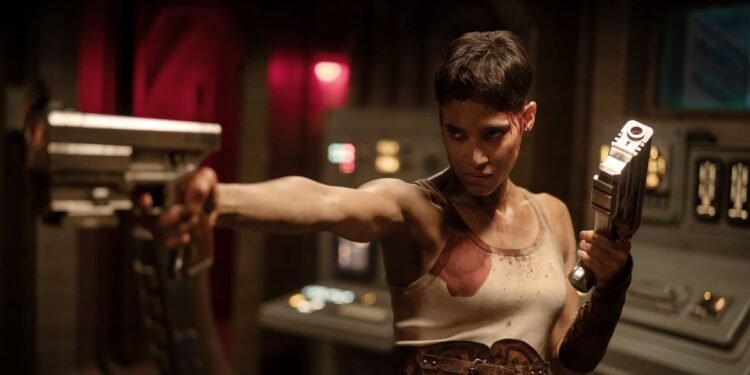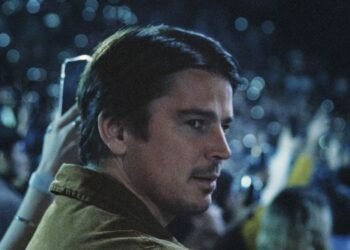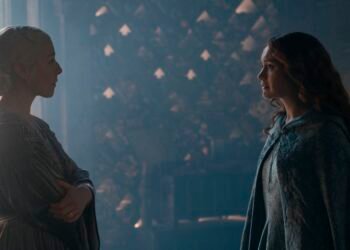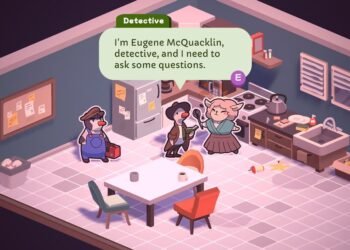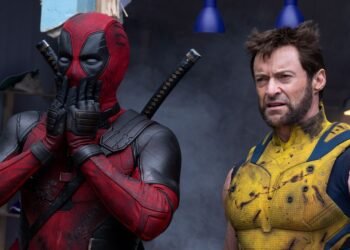Let’s start with a really great part: The teeth.
It’s a beat you might not have noticed at all in the original version of Zack Snyder’s Rebel Moon saga. The only time we really see any up close is when the dastardly Admiral Noble (Ed Skrein) gets his ass handed to him at the end of Part 1, and his knocked-out teeth skitter across the ground before tumbling thousands of feet into inky blackness. This being a Snyder joint, we see the shot in slow motion, but it reads like a hollow touch of visual flourish.
But, this being a Snyder joint with a director’s cut, it turns out to be a puff of brutal poetry that hits a lot harder in the longer version of the film. It turns out the priests Noble travels with collect a tooth from all of his victims and place them, artfully, around a portrait of their slain princess in some sort of perverse ritual.
It’s metal! The sort of wicked fun worldbuilding a major sci-fi blockbuster should have, especially when it’s carried out by guys in skull masks and red robes that mostly just stood in the background for the original cut of Rebel Moon: A Child of Fire, released last year. In the tiny close-up glimpses we got of them then, you could tell there was a lot of detail to their look, but we never really got to know their deal. That’s the beauty of Snyder’s new director’s cuts of Rebel Moon parts 1 and 2: it’s a longer gaze at a world that’s full and rich in a way the original cut never revealed. More importantly, it feels like the sort of thing you can build an incredibly lively franchise on.
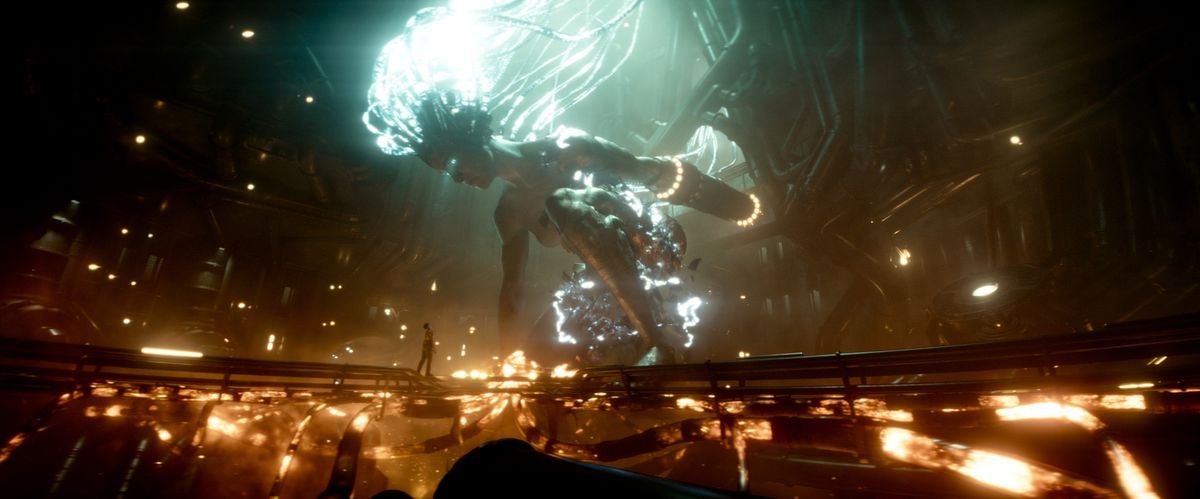
Image: Netflix
The bones of Rebel Moon’s story are the same in either version: Kora (Sofia Boutella) has been living on the remote planet of Veldt amid a small farming community, hiding from some mysterious past life. But after soldiers of the fascistic Imperium show up and demand all of the village’s grain, Kora is pushed back toward the violence she was trained for, and sets off traveling around the galaxy to recruit a band of soldiers to help protect the small town she’s grown to love. As with the original cuts, A Child of Fire and The Scargiver, it is what it seems: Star Wars meets Seven Samurai, with some Warhammer elements scattered in for seasoning.
But from the jump, the newly released director’s cuts — Chalice of Blood and Curse of Forgiveness — fill in what seemed lost from Snyder’s vision in the shorter versions. We open with an entirely new 20-minute action sequence, on a planet the originals never went to, a fire-bathed, blood-soaked world in a final stand against the Imperium. The sheer amount of splatter and nudity here makes it clear this isn’t your dad’s Rebel Moon; this is an R-rated film in full Snyder technicolor. And remarkably it all feels fairly fluid: It’s hard to imagine Rebel Moon without this first look at Noble’s moral fraudulence, to appreciate him killing a Veldt villager with the sacred bone staff, or the brutal rituals of his priests. As we come to understand (and as Rebel Moon will turn over again and again), Noble and his troops are brutal without honor, disreputable and barbarous on principle. It’s a key undercurrent, one lost in the originals where they were simple “The Very Worst.”

Photo: Clay Enos/Netflix

Image: Netflix
And this carries on throughout the director’s cuts, with dozens of small, additional scenes building toward better reveals and more plentiful worldbuilding. Nowhere is this more true than Jimmy, a robot voiced by Anthony Hopkins, whose journey is curiously sidelined in the original cut. He’s an android model originally designed to defend the royal family, now repurposed as manual labor because they all mysteriously refused to fight after their charges’ tragic deaths. Chalice of Blood checks in with him far more than Child of Fire did, coiling his story about retreating into nature to discover himself into the emotional core that informs everything Kora and her merry band of rebels fight against.
Like all things Snyder, the result is passionately earnest; a tale of what it means to fight for what you care about, what you believe in, what you deserve, and what you think you might not ever earn. And like all things Snyder, the whole thing feels like a beautiful conundrum. When you watch the original cuts, it’s clear they’ve been hampered by trying to be two-hour(ish) movies, per Netflix guidelines. And when you watch the extended versions, it’s clear this story was probably best served by the single four-hour film Snyder originally imagined. While Chalice of Blood feels like the relatively smooth three-and-a-half hour, action-packed adventure to get the gang together that we’d expect from the mind behind the Snyder Cut of Justice League, Curse of Forgiveness lags a bit as it bounces between backstory, battle, and barley farming. Taken as a single entity, the director’s cuts of Rebel Moon are too much. Taken as two individual films in a series, and you can see how the hoops hampered the vision.
The quandary of any Snyder film starts with the buy-in the audience is willing to extend to lengthy runtimes and the indulgences those extra minutes allow. And in Rebel Moon, they certainly give space for plenty of Snyder’s weaknesses as a filmmaker, particularly how aesthetic demands can often render certain pockets of feeling a bit more inert than they should be. Boutella’s Kora is the ostensible heart of the movie, but she’s a lot more capable in action than deep in her emotions. It’s tough to believe in the story’s commitment to love conquering all when there’s not a lot of chemistry that fizzes. But the director’s cut’s R-rating at least means sex scenes can help give Boutella back the physicality the wrought dialogue can rob from her.
But, if you can indulge Snyder’s mannerisms — and I think you should — the Rebel Moon director’s cuts are a flex of his creative power. Though the world clearly invokes other, stronger movies with its references, it never feels like a rip-off. (Even the obvious “lightsaber” swords feel like something distinctly their own.) Each plot digression is equal parts clumsy and artful, brimming with imagination and tiny details.
It’s an expansive and new world, proved better with each new Jimmy soliloquy, or human bar patron who’s actually being operated by a crustacean alien. There’s more character shining through the cracks in Rebel Moon that the sheen of most, more-polished modern blockbusters allow for. And unlike modern Star Wars, the universe’s expansiveness feels like an opportunity rather than gestured lore.
While I might quibble with a choice here or there, the failures of Rebel Moon feel minor and human, an imagination bursting with potential and missing a few beats here or there. Ultimately Chalice of Blood ends with a stronger promise for future installments than Curse of Forgiveness delivers, but even with lengthy runtimes and ample side quests, it never feels like Snyder is biting off more than he can chew here. Quite the opposite in fact: Neither Rebel Moon is perfect, but I’m sure as hell ready to sink my teeth into more of it.
All four version of Rebel Moon, including the latest director’s cuts Part 1 – Chalice of Blood and Part 2 – Curse of Forgiveness are on Netflix now.





























